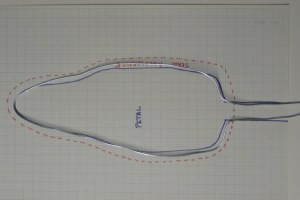Let's begin our flower design by drawing out the shape of one petal onto a sheet of paper. The maximum length of a petal is 15 inches. Stay in the 11 - 15 inch range for a petal as anything larger is not suited to these materials, and anything smaller is slightly more challenging to mosaic.

How many petals does your flower have? I am choosing five petals for my imaginary flower. Yours may be based on a real flower. If so, study the design of your flower and count how many petals it has. Make only one pattern for the petal shape.
The size of each petal is 11-15 inches long. To this we add another 6-7 inches for a stem. I like to measure about 6 inches of wire (14 gauge), make a mark, and then begin laying and shaping the wire to my pattern. As I come around the pattern to the end of the petal design, I add another 6 inches. Repeat this process until all the petals are formed. The petals will not be identical. Allow this to be OK as it follows the natural design of Mother Nature. Set the formed wires aside.

TIP: USE PAINTERS TAPE TO HOLD THE WIRE
IN PLACE AS YOU GO TO MAKE THIS PROCESS EASIER
Return to your pattern and add a 1/2 inch seam allowance to the outside edge of the petal drawing.

Unroll a section of aluminum mesh, double the width of the petal design. Fold in half along the length of the petal and trace the pattern onto the mesh using a permanent marker. Cut out the shape. This gives us two petals! Now repeat this process until you have cut out all the petals needed for your project.


Place a wire petal outline on top of one aluminum mesh petal and carefully fold the seam over the edges. Repeat for each petal.



Arrange petals, face down, and bend stems at a 90 degree angle. Tape stems together for ease in handling. The petals will be loose at this point so you can arrange them to suit your flower design.

Flip the flower over and begin to arrange and shape the petals. Remember, the wire is malleable and you can create just about anything. Do be careful and know the aluminum mesh can tear. If so, it can be mended. Once you have something close to what you are wanting to create, cut off some of the smaller gauge wire (2-3 inches) and begin sewing the seams of your petals together. I find needle nose pliers useful for pulling the wire threads through the mesh. The goal is to bind the petals together for a supported structure. Take your time and try to design your flower such that the lower parts of the petals can support one another. Make adjustments as needed.


My fantasy flower is looking like a tulip. If you are a beginner in mosaics, I recommend creating your flower with petals that are more open. This will be easier to mosaic than the flower I am creating here.
Take the time and care to reinforce the seams of your flower by stitching it together along the lines of the heavier gauge wire. Shape the petals, study your design in different lighting, and make sure the flower sculpture looks good to you. We will continue with the process on the 2nd Tuesday of next month.
Please leave a comment if you have any questions.
 Tuesday, December 20, 2011 at 4:11AM
Tuesday, December 20, 2011 at 4:11AM 














